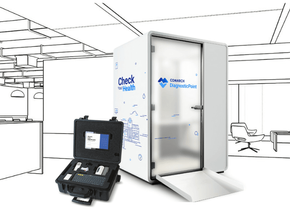AI in insurtech: Evolving the customer experience

Insurtech Digital asks the experts how AI in insurtech is evolving the customer experience for insurers, featuring:
- Guidewire Director of EMEA Product Marketing René Schoenauer,
- Charles Taylor Chief Product Officer Lautaro Mon,
- LexisNexis Risk Solutions SVP of Analytics and Insurance John Beal,
- and EXL SVP & Head of Insurance Mohit Manchanda
As the needs of consumers change, so too must technology match these changes. Insurtech Digital looks at how AI and machine learning are automation customer service in insurance, particularly chatbot and automated telephone experiences. We delve into ways AI is boosting personalised sales, particularly with regard to embedded insurance products, and look at how technology is making the claims process more efficient.
Furthermore, we speak to our experts about ways AI is making management policy and quote generation more efficient and look at how insurers are striking the balance between enhanced automation and retaining a human touch in the services they provide.
How is AI and machine learning automating customer service in insurance, and how is it improving the chatbot/automated telephone experience?
René Schoenauer
Insurers have deployed AI and machine learning into the claims processing, underwriting, and fraud detection arms of their business, and in this are using chatbots to improve customer service.
As chatbots are available 24/7 to assist customers and help with basic inquiries, such as completing common transactions and checking information, customers are able to get help when they need it.
At the same time, we should not underestimate the need for human touch for particularly stressful and non-standard claims situations.
In addition, AI and machine learning can be used by insurers during different parts of the claims-handling process to quickly gather and analyse information.
For example, machine learning can be used to analyse images and assess the severity of damages. It can then forecast the repair costs and book the repair with a verified provider, sharing the details with the customer instantly.
All of this can be done quickly and efficiently and significantly speeds up the settlement of the claim.
Lautaro Mon
In the insurance industry, AI-powered chatbots and virtual assistants are integral parts of customer service automation. Utilising machine learning algorithms and Natural Language Processing (NLP), these advanced systems offer a nuanced understanding of customer inquiries, extending from routine policy information to risk assessment.
This capability is mirrored in state-of-the-art automated telephone systems that not only efficiently direct customer calls but also analyse sentiment.
This technology allows insurers to offer a more customised, empathetic service, fitting into a broader strategy that combines human expertise with AI for improved customer interaction and satisfaction.
Virtual insurance agents or chatbots are also crucial in the application of AI in customer service. Unlike standard automated systems, these intelligent agents engage users in conversations that are both informative and enjoyable. They ask questions related to customers' needs, lifestyles, and preferences, gathering invaluable data.
More than mere data collectors, they act as brand ambassadors, setting a positive tone for all customer interactions.
John Beal
There is no shortage of data in insurance. AI and ML are helping insurance providers to operationalise all of this data, bringing it in at the right time to support quotes, price a risk, expedite a claim, flag possible fraud or understand a cross-sell opportunity.
AI/ML systems allow insurance providers the ability to condense large volumes of disparate data down to consumable insights. They are also helping consumers and businesses mitigate their own risks, to help prevent a claim from occurring.
Most insurance customers want simplicity, transparency and speed – from quote to claim. To achieve this, insurance providers are increasingly using automated processes, offering quicker ways of doing things with a greater degree of accuracy but without losing the human touch when it’s needed.
Mohit Manchanda
Customer service is ripe for transformation, with many opportunities to reduce friction for both customers and agents.
AI and machine learning are already transforming the quality of customer service that the insurance sector can offer - not just for automated chatbots (by recognising a customer’s needs and pulling historical data for more personalised chatbot experiences) but live telephone calls too.
For customer service in insurance, AI is improving the experience in two ways. First, conversational AI allows customers to self-serve across a range of digital channels.
Conversational AI or chatbots today are natural language-based and can easily personalise the journey based on customer intent, tone, and profile to handle simple to medium complexity queries in an efficient and empathetic manner.
Second, AI-based assistants, who listen to an ongoing call and provide transcription, intent identification, and next best action in real time, can help agents to understand different accents, provide the right information, and create a personalised experience for customers for medium to high-complexity queries.
AI can provide procedural guidance to agents, especially those who are new to their roles, to handle customer queries in a compliant yet customer-centric manner - something which is critical for a product as complex as insurance.
Making an agent’s work easier implicitly improves the experience of the customer. They experience shorter, more efficient calls and a faster resolution. We have seen over 40-50% more efficient query resolution in areas where AI has been deployed.
How is AI boosting personalising sales? And do embedded insurance offerings help with bespoke sales offers?
René Schoenauer
Embedded insurance in and of itself will not necessarily result in more personalised offerings, but we certainly see the increased availability and use of connected devices as offering opportunities for better tailoring of insurance products to customer’s needs.
AI will have a role to play here in that the data from devices will need to be analysed, and in some instances, different levels of cover may be activated based on the location of a car, for example, or whether someone is at home or not.
There is also a significant opportunity to go beyond insurance, if insurers can achieve the level of data analytics capabilities necessary. For a customer, preventing a loss event is even better than quickly and efficiently resolving one.
Through the use of sensors and AI, insurers have an opportunity to, for example, detect and stop a leak from becoming a major issue, or identify when a car is about to break down and needs a service.
In doing so, things that would cause major disruption end up being fairly routine fixes, letting the customer get on with their lives and leaving them much happier than had the loss event happened.
Lautaro Mon
AI is profoundly enhancing the personalisation of sales in the insurance industry. By leveraging technologies like virtual insurance agents and chatbots, insurers can gather critical insights into customer preferences, needs, and lifestyles.
For instance, intelligent, human-like avatars interact with potential customers through social media platforms or websites, asking questions that help in understanding the customer better.
This interaction allows for the creation of highly tailored insurance plans, which not only resonate with the customer on a deeply personal level but also increase the success rate of sales efforts. This synergy between AI and human expertise offers a unique, data-driven strategy to connect with customers more effectively.
John Beal
It follows that the more you can understand about a customer and their assets such as their home or vehicle, the more personalised the experience an insurance provider can offer.
It starts with better communication based on a better understanding of customer needs. Consider the volume of customer data held by insurance providers in claims, marketing, and underwriting – often held in different silos, sometimes in different sub-brands.
AI and ML techniques can help make quick and accurate sense of that data. This becomes all the more important in a market rife with merger and acquisition activity giving insurance providers a more holistic view of that individual to best support their needs.
How is AI making claims processes more efficient?
René Schoenauer
One of the most important ways AI is making claims processes more efficient is through analysing patterns in customer behaviour and detecting suspicious actions and potentially fraudulent claims.
This not only stops these claims from being processed, but the positive impact on an insurer’s loss ratio means better prices for customers too.
In addition, leveraging AI in claims processes ensures better claims routing and segregation depending on the predicted severity and likelihood of litigation risk. Within this process, automation is based on AI predictions.
Lautaro Mon
Insurers increasingly leverage AI-driven analytics to delve deep into individual customer preferences and behaviours.
This powerful technology enables a new degree of personalisation, allowing for the creation of highly tailored insurance plans and specific marketing campaigns.
By offering insights into customer behaviour and risk profiles, AI analytics serve as a critical tool for customising services and offers.
Such a level of personalisation not only targets conventional insurance products but also paves the way for innovative strategies like embedded insurance offerings.
Although your text does not explicitly mention embedded insurance, the depth of personalisation facilitated by AI suggests that bespoke sales offers, which could include embedded insurance options, can be crafted to align more closely with individual customer needs.
Overall, the role of AI in creating hyper-personalised experiences is pivotal, transforming how insurers interact with and serve their customers.
John Beal
Motor insurance claims are benefiting from AI/ML techniques. More and more insurance providers are using image recognition technology to capture damage or invoices. They then run a system audit to automatically authorise and settle the claim if their criteria are met.
This speeds up the process for both the insurance provider and the customer. In the very near future, historical policy, quote, and claims history may offer a further level of security prior to an insurer releasing any claim payments.
Many customers with telematics policies benefit from an improved claims experience thanks to AI and ML and this experience will be one of the key benefits to come from the connected car.
From the point of impact through to claim resolution, telematics data can allow insurance providers to get on the front foot at first notification of loss (FNOL), to support the customer post-accident with emergency services, roadside recovery, vehicle rentals, and repairs whilst providing invaluable insights regarding the circumstances of the collision.
Insurance providers can look at a range of data such as airbag deployment, impact sensor activation, and g-force metrics to understand claim severity and bodily injury potential. They can also bring in vehicle build data to understand the repair cost and potential impact of expensive ADAS features.
Mohit Manchanda
AI can assist in registering, processing, and paying out claims. It can automate the extraction of data from claims submissions; analyse documents, images, medical records, and legal notices to compare them against policy terms; finalise claims payouts; and identify patterns and anomalies in claim narratives for fraud detection.
Generative AI allows claims adjusters to access data not only from claims systems but policy admin and underwriting systems to get a holistic view of the customer’s claim progression, allowing for faster and more accurate decisions and proactive communication.
This proactive communication ensures that the claims journey has less friction for the customer and that the claims process enhances customer perceptions of the brand.
Is AI making policy management more easy/digestible?
Lautaro Mon
AI aids in streamlining administrative tasks such as policy management, premium calculations, and policy renewals.
Elements of gamification further encourage policyholders to adopt healthier lifestyles, thereby making policy management more interactive and engaging.
In light of rapid technological advancements and changing consumer expectations, it becomes evident that insurers cannot afford to regard AI and automation as static, one-time solutions.
Instead, they must consider customer service automation as a constantly evolving practice to stay abreast of these changes.
John Beal
AI and ML techniques enable data-based decisions to be made, at speed. In household insurance, for example, prefill and data validation solutions help make the whole application process quick and simple, improving pricing accuracy while cutting the time it takes for a customer to gain a quote. No more guessing at rebuild costs or property age.
This is only possible through a huge amount of modelling, linking, and AI-ML techniques to pull all the data together to return accurate and up-to-date information on the person and property.
In the US, we are using AI-enabled innovation to help consumers and insurers gather more information about the inside and outside of the home and the roof condition for underwriting, renewal and in the event of a claim.
For businesses needing new commercial property space, AI can provide valuable insights into the footfall, crime rate, exposure to perils, portfolio risk aggregation, or other local circumstances that increase the risk to the property.
Forewarned is forearmed, so access to these insights allows the customer to take preventative measures which has the benefit of reducing the risk and potential claims costs.
What about quote generation?
René Schoenauer
AI is able to quickly collate and analyse insights and ever-changing risk factors for consideration by the underwriter to support policy decisions.
Leveraging AI for quote generation means that underwriters have access to the most up-to-date threat analysis and risk factors to ensure that accurate quotes are created seamlessly. This also leads to the ability for insurers to offer dynamic pricing, which is based on predictive analytics and AI.
Within this, insurers could rate quotes based on customer retention or attraction criteria, in order to provide personalised customer service to current and future customers.
John Beal
Pricing insurance is based on a number of factors, including predicting the risk of a claim. Here machine learning algorithms speed the identification of the most predictive attributes behind claims losses for use at the point of quote.
For example, cancellations and gaps in coverage in motor insurance are predictive of claims but insurance providers also need to understand when those changes to policies occurred.
A great example of this is the ML techniques that allowed them to distinguish between policy changes directly related to national lockdowns versus changes that occurred outside of those times to support the fairest treatment of customers when they come to buy or renew their next motor annual policy.
Protecting the consumer’s identity and personal information is another important role AI and ML play.
Is it still important to retain a balance between technological upgrades to customer service and maintaining a human touch? Where should the line be drawn?
René Schoenauer
Customers expect their claims to be paid out faster but want to feel as if they are being valued. Striking a balance between the two means using both AI and humans hand in hand.
In our annual report, How Insurers Can Support Their Customers In Uncertain Times, the majority of customers (56 percent), said that they prefer to make a claim over the phone and 39% over email. Perhaps surprisingly, 20% of 18–24-year-olds would prefer their insurance agent to file their claim on behalf of them.
The human touch in insurance is still needed and insurers must consider how they can provide better personalised support and increase their customers’ confidence.
Lautaro Mon
Absolutely, it’s by combining the best of AI with human expertise that better service to customers can be delivered, as well as more accurate risk assessments and ethical decisions made.
Human claims adjusters review AI-generated insights, while human agents step in for complex or sensitive customer service issues.
John Beal
It's hard to think of a data-driven, digital business that does not need to retain this balance. Consumers can become frustrated if the only line of communication is automated customer service.
To commit too far in the other direction and enforce all interaction to have a human touch can have equally damaging results. Automated processes are designed to lessen the strain on an organisation’s resources and accelerate day-to-day tasks.
These can even save consumers time in cases where they are looking for a simple, quick quote or way to lodge a claim.
As well as speed, transparency, and simplicity, customers want consistency and reliability from their insurance provider – when that is delivered trust is built.
Data-driven automation employing technology, artificial intelligence, and ML helps provide consistency and reliability as the backbone of an insurance provider’s proposition, freeing insurance providers to offer the personal touch when it’s needed.
Mohit Manchanda
Insurance products are sensitive; they’re invested in earlier to provide support if life gets tough later.
When agents are dealing with customers, that customer on the other end is usually at a vulnerable point – their property may be seriously damaged or they themselves may be hurt.
AI can assist that customer by speeding up the process of getting them the advice and help they need.
Still, it should not overtake the human element of customer experience or replace the agents themselves.
On its own, AI can perform many tasks and transform the entire customer service experience for insurance customers, but it simply cannot synthesise the empathy and understanding that a human agent can provide.
Insurers must engage with the experts on AI – whether external or internally hired professionals – who can identify at what points in the customer service journey AI can make a difference.
For example, EXL’s smart agent assist solution works in conjunction with the agent in real-time to help with a service conversation as it happens.
This way, the customer can benefit from the real human touch of an agent on the line, but the agent is supported by an AI assistant which identifies and analyses queries, providing tangible insights in real-time to help them resolve queries efficiently.
The use of AI for audit also ensures that we can ensure that every customer service interaction is done in a compliant and customer-centric manner with any deviations leading to agent coaching and improvement discussions.
Consumer’s technology preferences are, today, changing at a rapid pace. How important is it that insurers see customer service automation as a practice in need of constant evolution?
With rapidly changing consumer technology preferences, insurance firms must regard customer service automation as an ever-evolving practice. Constant adaptation is essential for meeting customer expectations effectively.
AI and automation are not static solutions; they are tools that continually adapt to align with consumer needs and business objectives.
AI exerts significant changes, including hyper-personalised customer experiences and AI-driven risk prevention. These innovations highlight that insurers recognise the need for continuous innovation to meet consumer expectations.
This manifests in features like the "AI-Powered Hyper-Intuitive Customer Experience," where insurers can employ advanced AI interfaces, such as holographic avatars, to adapt to consumers' growing comfort with and expectations for high-tech interactions.
As technology advances, so will consumer preferences for how they wish to interact with services. If insurers fail to keep their customer service automation tools up-to-date, they risk not only operational inefficiency but also a growing disconnect with their customer base, which could directly impact business growth.
John Beal
Consumer expectations are evolving quickly, especially where technology preferences are concerned. When applying for a new policy, submitting a claim, or prospecting renewals, consumers increasingly expect automation and simplicity using the technology they are familiar and comfortable with.
Keeping pace with this expectation is front of mind for much of the insurance sector but what we need to remember is that behind every automated service is data to drive those decisions and responses. The right data has to be injected at the right point at the right time in the customer journey to smooth the customer experience – whatever the technology used.
Mohit Manchanda
It is not just customers’ technology preferences that are changing - their expectations of customer service are evolving, too.
In today’s economic climate, financial difficulties mean customers have a lower harm threshold; insurance firms must make their critical customer services resilient to provide more tailored and responsive support.
Today, insurance brands are held to the same standards as retail and customer service brands, which is the experience that customers benchmark them against.
Such higher expectations of service go together with an expectation of better technology, which keeps pace with the technological evolution customers see in their day-to-day lives.
They have become accustomed to omnichannel service options, faster responses, sleeker journey design, and personalised recommendations that meet their needs. They are naturally frustrated when the frictionless experience is not available to them when contacting their insurer.
Historically, the insurance sector has been slow to modernise, but this attitude is changing, and AI is the catalyst. In the race to invest in AI capabilities to keep pace with competitors and transform business operations, we are seeing an increased appetite for emerging technology among insurers.
However, it is also important that apart from AI technology, insurers ensure that AI is used responsibly and that customer and data privacy is protected.
Trust is the bedrock of an insurance business, and it is important that despite the advent of modern and new technology, it remains the foundational pillar of an insurer’s relationship with its customers.







